The Ventricle Assist Device Market is estimated to be valued at USD 4.0 billion in 2025 and is projected to reach USD 20.5 billion by 2035, registering a compound annual growth rate (CAGR) of 17.6% over the forecast period.
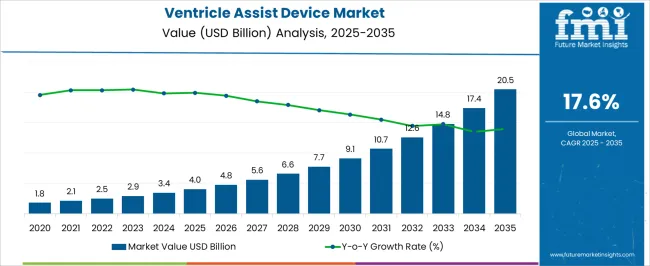
| Metric | Value |
|---|---|
| Ventricle Assist Device Market Estimated Value in (2025 E) | USD 4.0 billion |
| Ventricle Assist Device Market Forecast Value in (2035 F) | USD 20.5 billion |
| Forecast CAGR (2025 to 2035) | 17.6% |
The ventricle assist device market is witnessing significant growth driven by the rising prevalence of advanced heart failure and increasing demand for mechanical circulatory support solutions. The market expansion is being influenced by innovations in device design, enhanced biocompatibility, and improvements in durability and operational efficiency. Growth is further supported by increasing investments in healthcare infrastructure, specialized cardiac centers, and the availability of skilled cardiothoracic surgeons.
Adoption is being encouraged by the rising number of heart transplant candidates who require temporary or long-term support, as well as the growing elderly population prone to cardiovascular complications. Technological advancements, including minimally invasive implantation procedures, compact device designs, and remote monitoring capabilities, are improving patient outcomes and reducing hospital stays.
Regulatory approvals and reimbursement policies in key regions are also facilitating wider accessibility of ventricle assist devices As awareness of mechanical circulatory support benefits continues to rise and the focus on heart failure management intensifies, the market is expected to sustain strong growth over the forecast period.
The ventricle assist device market is segmented by modality, product type, indication, end user, and geographic regions. By modality, ventricle assist device market is divided into Implantable Ventricle Assist Devices and Transcutaneous Ventricle Assist Devices. In terms of product type, ventricle assist device market is classified into LVAD (Left Ventricle Assist Devices), RVAD (Right Ventricle Assist Devices), Bi-VAD (Bi-Ventricle Assist Devices), and TAH (Total Artificial Heart). Based on indication, ventricle assist device market is segmented into Bridge To Transplant, Bridge To Recovery, and Bridge To Therapy. By end user, ventricle assist device market is segmented into Hospitals, Specialized Cardiac Clinics, and Ambulatory Surgical Centers. Regionally, the ventricle assist device industry is classified into North America, Latin America, Western Europe, Eastern Europe, Balkan & Baltic Countries, Russia & Belarus, Central Asia, East Asia, South Asia & Pacific, and the Middle East & Africa.
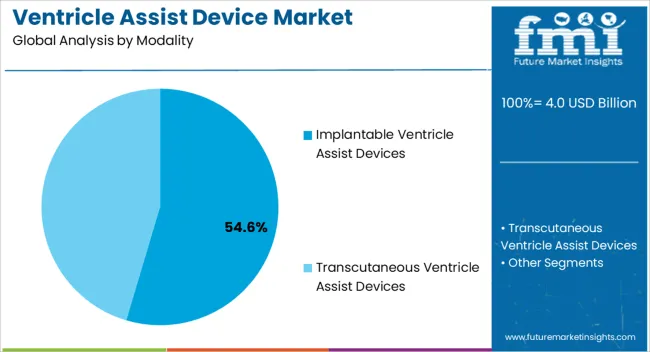
The implantable ventricle assist devices segment is projected to hold 54.6% of the ventricle assist device market revenue share in 2025, positioning it as the leading modality. This dominance is being driven by the segment’s ability to provide continuous hemodynamic support over extended periods, improving survival and quality of life for patients with advanced heart failure. Implantable devices are preferred due to their durability, compact form factor, and capacity for long-term use in bridge-to-transplant or destination therapy settings.
Technological enhancements, including reduced thrombogenicity and improved flow dynamics, have minimized complications and increased patient acceptance. The segment’s adoption is also being reinforced by the availability of comprehensive post-implant monitoring systems, which enhance patient management and reduce hospital readmissions.
Rising awareness among cardiologists and patients about the benefits of continuous support versus external devices is further supporting growth As hospitals and cardiac centers increasingly integrate advanced cardiac assist solutions, implantable ventricle assist devices are expected to maintain a leading position in the market.
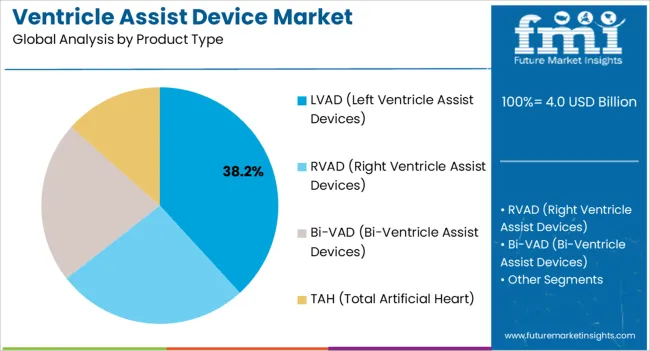
The left ventricle assist devices (LVAD) product type segment is expected to capture 38.2% of the ventricle assist device market revenue share in 2025, establishing it as the dominant product type. LVADs are being favored due to their targeted support for left ventricular dysfunction, which is the most common form of advanced heart failure.
The ability of LVADs to sustain cardiac output effectively allows patients to remain active while awaiting heart transplantation or as long-term therapy. Innovations in pump design, energy efficiency, and reduced complication rates have enhanced patient outcomes and increased clinician confidence.
Integration with remote monitoring and patient management systems has also facilitated proactive intervention, reducing adverse events and improving long-term survival rates As the burden of heart failure continues to rise globally and the demand for transplant bridging solutions grows, LVADs are anticipated to remain the leading product type in the market, with strong adoption across specialized cardiac care centers.
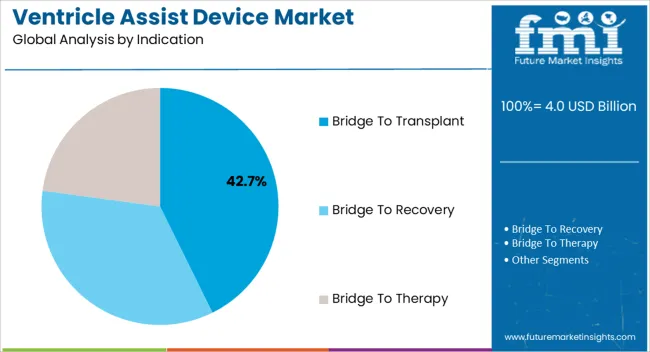
The bridge to transplant indication segment is projected to hold 42.7% of the ventricle assist device market revenue share in 2025, making it the leading indication category. This segment is being driven by the increasing number of patients with end-stage heart failure who require temporary mechanical support while awaiting heart transplantation. The ability of ventricle assist devices to stabilize hemodynamics and improve end-organ function prior to transplant has been instrumental in reducing mortality and optimizing transplant outcomes.
Hospitals and cardiac centers are increasingly adopting these devices as standard pre-transplant care, supported by clinical guidelines and evidence-based practices demonstrating improved survival rates. Advances in device technology, including reduced risk of thrombosis, hemolysis, and infection, have increased patient eligibility and acceptance.
Growing awareness among physicians and patients regarding the benefits of temporary mechanical support prior to transplant is further reinforcing adoption As organ donor shortages persist and the need for pre-transplant stabilization increases, the bridge to transplant indication is expected to continue leading the market in revenue share.
The global ventricle assist device market is anticipated to be worth US$ 2.49 Billion in terms of revenue in 2025. The market is projected to expand at a CAGR of 17.6% to reach a market size of US$ 12.59 Billion by 2035.
| Attributes | Details |
|---|---|
| Ventricle Assist Device Market CAGR | 17.6% |
| Ventricle Assist Device Market (2025) | US$ 2.49 Billion |
| Ventricle Assist Device Market (2035) | US$ 12.59 Billion |
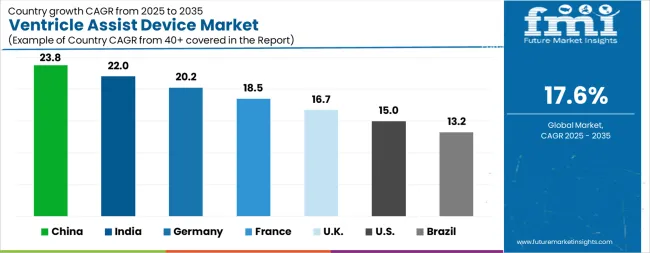
| Country | CAGR |
|---|---|
| China | 23.8% |
| India | 22.0% |
| Germany | 20.2% |
| France | 18.5% |
| UK | 16.7% |
| USA | 15.0% |
| Brazil | 13.2% |
The Ventricle Assist Device Market is expected to register a CAGR of 17.6% during the forecast period, exhibiting varied country level momentum. China leads with the highest CAGR of 23.8%, followed by India at 22.0%. Developed markets such as Germany, France, and the UK continue to expand steadily, while the USA is likely to grow at consistent rates. Brazil posts the lowest CAGR at 13.2%, yet still underscores a broadly positive trajectory for the global Ventricle Assist Device Market. In 2024, Germany held a dominant revenue in the Western Europe market and is expected to grow with a CAGR of 20.2%. The USA Ventricle Assist Device Market is estimated to be valued at USD 1.4 billion in 2025 and is anticipated to reach a valuation of USD 5.8 billion by 2035. Sales are projected to rise at a CAGR of 15.0% over the forecast period between 2025 and 2035. While Japan and South Korea markets are estimated to be valued at USD 196.7 million and USD 132.9 million respectively in 2025.
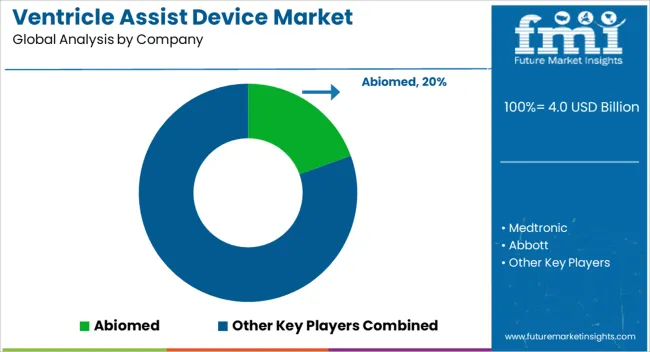
| Item | Value |
|---|---|
| Quantitative Units | USD 4.0 Billion |
| Modality | Implantable Ventricle Assist Devices and Transcutaneous Ventricle Assist Devices |
| Product Type | LVAD (Left Ventricle Assist Devices), RVAD (Right Ventricle Assist Devices), Bi-VAD (Bi-Ventricle Assist Devices), and TAH (Total Artificial Heart) |
| Indication | Bridge To Transplant, Bridge To Recovery, and Bridge To Therapy |
| End User | Hospitals, Specialized Cardiac Clinics, and Ambulatory Surgical Centers |
| Regions Covered | North America, Europe, Asia-Pacific, Latin America, Middle East & Africa |
| Country Covered | United States, Canada, Germany, France, United Kingdom, China, Japan, India, Brazil, South Africa |
| Key Companies Profiled | Abiomed, Medtronic, Abbott, Berlin Heart, Cardiac Assist, Inc., Jarvik Heart, Inc., ReliantHeart, Inc., and Sun Medical Technology Research Corp |
The global ventricle assist device market is estimated to be valued at USD 4.0 billion in 2025.
The market size for the ventricle assist device market is projected to reach USD 20.5 billion by 2035.
The ventricle assist device market is expected to grow at a 17.6% CAGR between 2025 and 2035.
The key product types in ventricle assist device market are implantable ventricle assist devices and transcutaneous ventricle assist devices.
In terms of product type, lvad (left ventricle assist devices) segment to command 38.2% share in the ventricle assist device market in 2025.






Full Research Suite comprises of:
Market outlook & trends analysis
Interviews & case studies
Strategic recommendations
Vendor profiles & capabilities analysis
5-year forecasts
8 regions and 60+ country-level data splits
Market segment data splits
12 months of continuous data updates
DELIVERED AS:
PDF EXCEL ONLINE
Assisted Living Software Market by Deployment, Amenity Type, and Region-Forecast through 2035
Assisted Walking Devices Market Size and Share Forecast Outlook 2025 to 2035
Assistive Listening Devices Market
AI Assisted Robots Market
Coil Assisted Flow Diverters Market – Growth, Demand & Forecast 2025 to 2035
Park Assist System Market Growth - Trends & Forecast 2025 to 2035
Robot Assisted Surgical Microscope Market Size and Share Forecast Outlook 2025 to 2035
Voice Assistance Application Market Size and Share Forecast Outlook 2025 to 2035
Voice Assistants Market Analysis - Size and Share Forecast Outlook 2025 to 2035
Remote Assist Headrest Market Size and Share Forecast Outlook 2025 to 2035
Stroke Assistive Devices Market
Robotic Assisted Endovascular Systems Market Size and Share Forecast Outlook 2025 to 2035
Virtual Assistant Services Market Size and Share Forecast Outlook 2025 to 2035
Trailer Assist System Market
Cardiac Assist Devices Market Growth – Trends & Forecast 2025 to 2035
Robotics-Assisted Telesurgery Market Size and Share Forecast Outlook 2025 to 2035
Hardware-Assisted Verification Market Size and Share Forecast Outlook 2025 to 2035
Computer Assisted Coding Software Market Analysis by Solution, Deployment, Application, and Region Through 2035
Eldercare-Assistive Robots Industry Analysis in East Asia Size and Share Forecast Outlook 2025 to 2035
Eldercare Assistive Robots Market Size and Share Forecast Outlook 2025 to 2035

Thank you!
You will receive an email from our Business Development Manager. Please be sure to check your SPAM/JUNK folder too.
Chat With
MaRIA